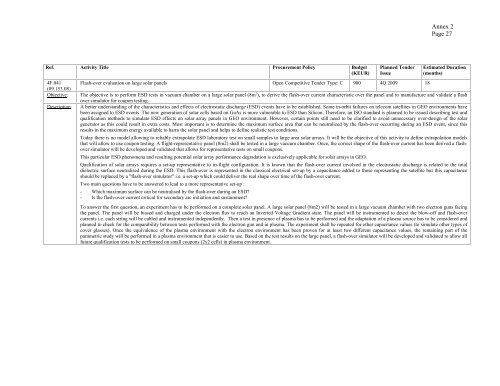ARTES-5.1 â ESA Telecom Technology Workplan ... - Emits - ESA
ARTES-5.1 â ESA Telecom Technology Workplan ... - Emits - ESA
ARTES-5.1 â ESA Telecom Technology Workplan ... - Emits - ESA
- No tags were found...
Create successful ePaper yourself
Turn your PDF publications into a flip-book with our unique Google optimized e-Paper software.
Annex 2Page 27Ref. Activity Title Procurement Policy Budget(KEUR)4F.041(09.153.08)Objective:Description:Planned TenderIssueFlash-over evaluation on large solar panels Open Competitive Tender Type: C 900 4Q 2009 18Estimated Duration(months)The objective is to perform ESD tests in vacuum chamber on a large solar panel (8m 2 ), to derive the flash-over current characteristic over the panel and to manufacture and validate a flashover simulator for coupon testing.A better understanding of the characteristics and effects of electrostatic discharge (ESD) events have to be established. Some in-orbit failures on telecom satellites in GEO environments havebeen assigned to ESD events. The new generation of solar cells based on GaAs is more vulnerable to ESD than Silicon. Therefore, an ISO standard is planned to be issued describing test andqualification methods to simulate ESD effects on solar array panels in GEO environment. However, certain points still need to be clarified to avoid unnecessary over-design of the solargenerator as this could result in extra costs. Most important is to determine the maximum surface area that can be neutralized by the flash-over occurring during an ESD event, since thisresults in the maximum energy available to harm the solar panel and helps to define realistic test conditions.Today there is no model allowing to reliably extrapolate ESD laboratory test on small samples to large area solar arrays. It will be the objective of this activity to define extrapolation modelsthat will allow to use coupon testing. A flight-representative panel (8m2) shall be tested in a large vacuum chamber. Once, the correct shape of the flash-over current has been derived a flashoversimulator will be developed and validated that allows for representative tests on small coupons.This particular ESD phenomena and resulting potential solar array performance degradation is exclusively applicable for solar arrays in GEO.Qualification of solar arrays requires a set-up representative to in-flight configuration. It is known that the flash-over current involved in the electrostatic discharge is related to the totaldielectric surface neutralised during the ESD. This flash-over is represented in the classical electrical set-up by a capacitance added to those representing the satellite but this capacitanceshould be replaced by a "flash-over simulator" i.e. a set-up which could deliver the real shape over time of the flash-over current.Two main questions have to be answered to lead to a more representative set-up :- Which maximum surface can be neutralised by the flash-over during an ESD?- Is the flash-over current critical for secondary arc initiation and sustainment?To answer the first question, an experiment has to be performed on a complete solar panel. A large solar panel (8m2) will be tested in a large vacuum chamber with two electron guns facingthe panel. The panel will be biased and charged under the electron flux to reach an Inverted Voltage Gradient state. The panel will be instrumented to detect the blow-off and flash-overcurrents i.e. each string will be cabled and instrumented independently. Then a test in presence of plasma has to be performed and the adaptation of a plasma source has to be considered andplanned to check for the comparability between tests performed with the electron gun and in plasma. The experiment shall be repeated for other capacitance values (to simulate other types ofcover glasses). Once the equivalence of the plasma environment with the electron environment has been proven for at least two different capacitance values, the remaining part of theparametric study will be performed in a plasma environment that is easier to use. Based on the test results on the large panel, a flash-over simulator will be developed and validated to allow allfuture qualification tests to be performed on small coupons (2x2 cells) in plasma environment.
















